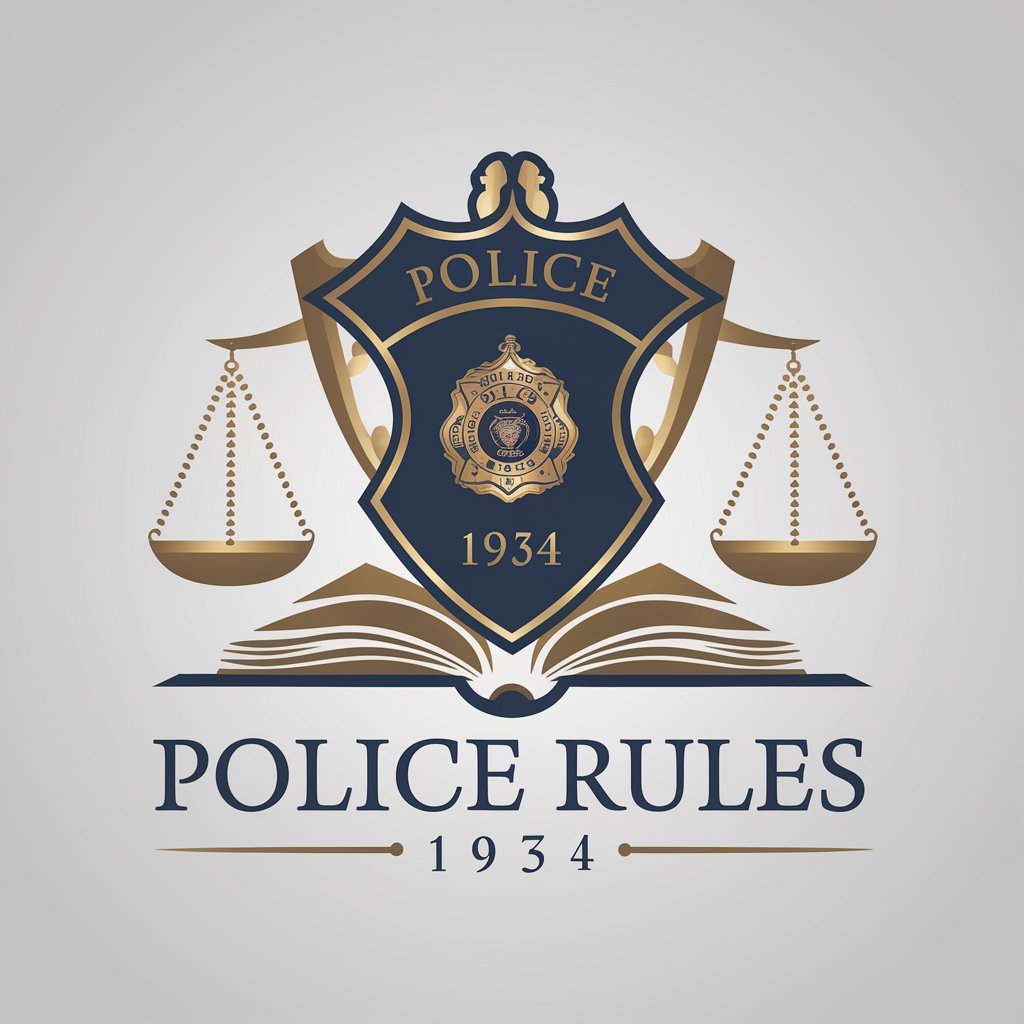Police Rules 1934 - Comprehensive Legal Reference

Hello, how can I assist you with the Punjab Police Rules 1934 today?
Your AI-powered guide to Punjab Police regulations
Explain the appointment process for Assistant Superintendents of Police in Punjab according to the Police Rules 1934.
Describe the qualifications required for direct appointments as Inspectors in the Punjab Police.
What are the rules governing the seniority and probation of Deputy Superintendents of Police?
Detail the process for the medical examination of police recruits as per the Punjab Police Rules 1934.
Get Embed Code
Introduction to Police Rules 1934
The Police Rules 1934 of Punjab, Pakistan, are a comprehensive set of regulations established to guide the functioning and organization of the police force in the region. These rules cover various aspects of police work, including administration, discipline, recruitment, training, and conduct of police personnel. They are designed to ensure that the police operate efficiently, transparently, and in accordance with the law, providing examples such as the detailed procedures for the appointment of different ranks within the police, the standards for physical fitness, and the protocols for handling complaints against police personnel. Powered by ChatGPT-4o。

Main Functions of Police Rules 1934
Regulation of Appointments and Enrolments
Example
Rules outline the process for appointing various police ranks, including the necessary qualifications, selection procedures, and seniority considerations.
Scenario
For instance, Rule 12.1 details the authorities empowered to make appointments, specifying the qualifications and procedures for appointing Assistant Superintendents of Police and other ranks.
Establishing Training and Probation Standards
Example
The rules stipulate training requirements and probationary conditions for newly appointed police personnel.
Scenario
Rule 12.8 discusses the probationary nature of appointments for ranks such as Inspectors and Sub-Inspectors, including the conditions for their confirmation or dismissal.
Defining Conduct and Discipline
Example
Police Rules provide comprehensive guidelines on the expected conduct of police personnel and the disciplinary actions for violations.
Scenario
This includes protocols for addressing complaints against police officers, maintaining integrity and professionalism, and ensuring that officers adhere to ethical standards.
Ideal Users of Police Rules 1934 Services
Police Personnel
Police officers at all levels use the rules to understand their responsibilities, rights, and the procedures they need to follow in their daily duties, ensuring that their actions are legally compliant and aligned with best practices.
Legal Professionals
Lawyers, judges, and legal advisors refer to the Police Rules to understand the legal framework governing police actions, which aids in legal proceedings, policy formulation, and ensuring accountability within the police force.
Academics and Researchers
Individuals studying law enforcement, criminal justice, or related fields use these rules as a resource to analyze policing standards, practices, and the evolution of law enforcement in the Punjab region.

How to Use Police Rules 1934
Sign up for a trial
Visit yeschat.ai for a hassle-free trial, requiring no sign-up or subscription to ChatGPT Plus.
Identify your need
Determine the specific information or clarification you require from the Police Rules 1934.
Consult the rules
Refer to the relevant volume and chapter of the Police Rules 1934 that corresponds to your question or need.
Interpret the rules
Understand the context and application of the rules to your particular situation or question.
Apply the information
Use the insights gained from the rules to inform decisions, actions, or further inquiries.
Try other advanced and practical GPTs
non-official SalesAutopilot API Guide by Harmat Á
Harness AI for smarter SalesAutopilot integration

ERG Assistant
AI-powered emergency hazmat guidance.

Cheap Flights
AI-powered Affordable Air Travel

Quantum Scholar
Powering Complex Calculations with AI

Geo Analyst Pro
Unlock Spatial Insights with AI

Math Mentor
AI-powered precision in mathematics.

Design Studio Assistant
AI-powered Personalized Design Guidance

WindowCurtainGPT
Design your dream curtains effortlessly.

CurtainSmith ChatBot
Your AI-Powered Curtain Expert

Who Wants to Be a Millionaire?
Climb the ladder to a million with AI!

MarketSpyAI | See What Your Market Wants 🔎
Uncover What Your Market Truly Desires

Ashley Wants A Puzzle Game
Craft Engaging Puzzles with AI

Q&A on Police Rules 1934
What are the qualifications required for a direct appointment as Inspector?
Direct appointments as Inspector require physical fitness certification by a Civil Surgeon, moral character, good physique, age between 18-25, a graduate degree, and passing Punjabi Language of Matriculation Standard.
How is the seniority of Deputy Superintendents of Police determined?
The seniority of Deputy Superintendents of Police is regulated by orders from the Secretary of State and the Central Government, considering the length of continuous service and merit.
What are the guidelines for recruitment of constables?
Constables are recruited based on physical standards, character verification, medical examination, and successful completion of training. Their enrollment and discharge are governed by specific rules within the Police Rules 1934.
What are the responsibilities of a Police Zaildar?
A Police Zaildar is responsible for the prevention and detection of crime within their assigned area, reporting cognizable cases to the police station, and aiding the police station's officer in charge.
How is the probationary period managed for newly appointed officers?
Newly appointed officers, such as Inspectors and Sub-Inspectors, are placed on probation for a specified period, during which they must pass prescribed examinations and demonstrate suitability for continued service.
